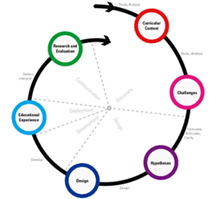About Design Research at CCNMTL
The Columbia Center for New Media Teaching and Learning (CCNMTL) is a unique service organization that works with faculty to develop new tools to advance the purposeful use of new media and digital technologies within academic programs.
The Design Research methodology guides our collaborations with our faculty partners. Together, we work through an iterative cycle of research, development, and assessment to create innovative uses of technology in the field of new media teaching and learning.
About Our Methodology
Design Research integrates the exploration and development of digital technologies with pedagogical theory and practice. CCNMTL rejects the long-standing division between theory-oriented educational research and service-oriented technical support and development. We seek to combine research and practice in a process that can best be summarized with a simple phrase: "build to learn."
 |
|
Click image to view a graphic representation of the Design Research process, or view a flash animation of Design Research. |
The Design Research process for developing classroom innovations begins by partnering with faculty members to discuss their teaching practices. This conversation unfolds in a series of discussions around the following stages to incorporate successful innovative practices into the University's repertoire of academic tools:
Initial Understanding of Curriculum: What is the purpose of this course within the department's curriculum? We begin by analyzing a course's curricular context.
Problems and Challenges: What kind of challenges does this course pose? We work to identify specific challenges and obstacles that make up the learning environment.
Design Hypothesis: How can technology be used to facilitate learning? We work with faculty to articulate and identify new media solutions to enhance the educational experience.
Design of the Educational Experience: How should solutions be designed? These decisions determine the content, activities, and interactions that constitute the learning environment.
Educational Experience: What learning experiences does the design enable? The project is implemented in the classroom, and its use is closely monitored.
Discussion of Research and Evaluation: What have we learned? We evaluate the process and articulate conclusions for improving the project. It is important to mention that this discussion is made possible through continuous documentation throughout the entire process. The evaluation process informs future iterations.
Design Research Resources
For more information on the Design Research process, we recommend the following resources:
- Bereiter, C. “Design Research for Sustained Innovation.” Cognitive Studies: Bulletin of the Japanese Cognitive Science Society 9 no. 3 (2002): 321-327.https://ikit.org/fulltext/2002Design_Research.pdf (PDF: 28kb)
- Edelson, Daniel. “Design Research: What We Learn When We Engage in Design.” The Journal of the Learning Sciences. 11 no. 1 (2002).
- Reeves, Thomas C. “Enhancing the Worth of Instructional Technology Research through ‘Design Experiments’ and Other Development Research Strategies.” Paper presented at the Annual Meeting of the American Educational Research Association, New Orleans, LA. 2000. https://it.coe.uga.edu/~treeves/AERA2000Reeves.pdf (PDF: 48kb)


